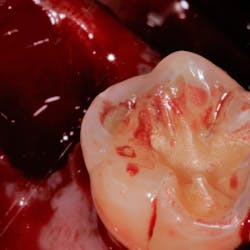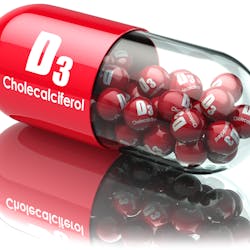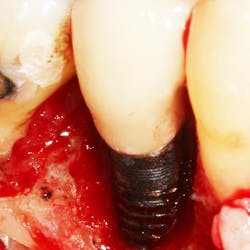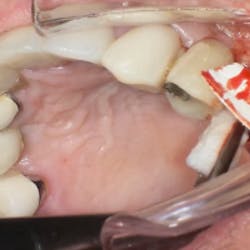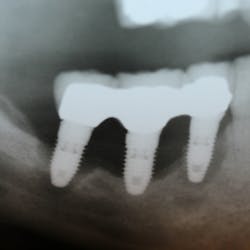A lot has happened since Dr. Branemark invented the first oral implant decades ago. Implant surgery has moved from being a fairly invasive, time-consuming, overhead costly, and unpredictable procedure to being a very minimally invasive, efficient, overhead-friendly, and predictable procedure in the GP practice. Now that specialists have embraced GPs placing routine implants on a daily basis in their family practices, legions of dentists in the United States are incorporating implants in a much larger way. Busy GPs who place implants also refer a much greater number of implants to local specialists. The top GP practices that coincidentally provide implant dentistry have evolved the implant procedures themselves to facilitate synergistic integration into the normal, daily GP routine. You see, about 85% of implant training for GPs today is administered by specialists using tools, techniques, and protocols. An oral surgeon's GP training, for instance, will have a heavy emphasis on the bone while the periodontist will focus on detailed soft-tissue techniques. Neither will emphasize tools and techniques that are immediately amenable to the GP. Top GP implant practices have allowed specialist trained techniques to evolve into specific implant procedures that emphasize tools and techniques that are readily available in the standard GP practice. These procedures also incorporate skill sets already being used on a daily basis by the standard general practitioner. Many GPs believe that the next five years will be the second golden age of dentistry due to 1. The rapid expansion of patient education with regard to implants, 2. currently the highest fee per procedure per ADA codes, and 3. minimally invasive implant procedures geared toward the busy GP practice.
RELATED |An alternative to conventional dental implants: short implants
Let's briefly overview the three procedures that I promise will transform your practice if you choose to dig deeply into them.
The first procedure that I would like to review is called the 3 in 1 Implant Procedure. Many GPs call this the 5-minute Implant, Abutment and Crown procedure. This simply means that what used to take implant dentists three appointments to accomplish is now accomplished in one, relatively brief, single appointment. It is a huge benefit to your patients because there is less time investment in the dental office and there is typically much less discomfort associated with the procedure. The reduction in discomfort is largely related to the usage of one of the top five minimally invasive, no suture, soft-tissue accesses. Remember, bone is not innervated, nerves may travel through the bone but do not directly innervate. Any discomfort related to an implant procedure postsurgically is caused by soft tissue. When we provide less invasive surgery, we reduce soft tissue involvement and thus pain. The three in one implant procedure is applicable for almost any edentulous area in the mouth that is suitable. The initial soft-tissue access and first 2 to 5 mm of the pilot hole in bone are created using a circular motion with the high-speed handpiece and a Duo-bur. Final osteotomy is created and the implant is placed. Immediately after implant placement, a final impression is taken after customizing a straight stock abutment, placing wax in the top of the abutment, and taking a standard check bite or full tray impression.
Of all of the advances made in implant dentistry over the last 10 years, the No-Drill Implant Procedure, using an Osteoconverter, has had the greatest impact on the general practitioner’s productivity and patient satisfaction. Immediately after extracting a tooth, an Osteoconverter is inserted with a spiraling motion into the socket, which achieves two important tasks: 1. The PDL is scored in roughly 2 mm increments allow,ing blood flow and highly bone forming cells to enter the site. 2. The unique curvature of the root is "converted" to a cylindrical shape, which allows for an implant-worthy osteotomy. The Osteoconverter doubles as OsteoReady's Prestige series implant. Clinicians who place OsteoReady implants may leave the Osteoconverter in place after inserting to serve as the final implant. The Prestige implant doubles as an instrument, the Osteoconverter which is a hybrid between a bone condenser and osteotomb. If the clinician uses another company's implant, simply use the Osteoconverter to convert the site, remove the Osteoconverter by unscrewing counterclockwise and insert a final implant. The majority of GPs who learn this procedure are able to immediately incorporate it into their busy practices. In many practices, about 50% of extractions have transformed to extraction and implant cases using the No-Drill Implant Procedure. Undoubtedly, the extraction takes more time to complete than the implant procedure. Join the hundreds of GPs who are successfully placing no drill implants in their practices using the Osteoconverter.
The third and final procedure that is transforming GP practices around the nation is the 1-Drill Implant Procedure. Quite simply, instead of the clinician going through a series of four or five drills to complete one osteotomy, one drill is used to complete the final osteotomy. The drill is called a multi-drill and has the widths of four to five drills built into the drill. This procedure is transforming the versatility of implantology in the general dental practice much like recent advances in endodontics have benefitted the general practitioner. The one-drill implant may be placed into an immediate extraction site or an area that has been edentulous for the short or long term. The 1-drill procedure relies on two important variables: 1. The drill used must be end-cutting, side-/axial-cutting, and have a modified taper (6% is ideal). 2. The implant used with the 1-drill procedure should ideally have aggressive threading, a 6% taper, and be self-tapping. (OsteoReady's Prestige series implants are approved for this procedure.) By utilizing a tapered drill, the osteotomy is wider toward the coronal aspect (more dense cortical plate bone) and more narrow apically (generally softer type 2/3 bone). Maxillary 1-drill implants are inserted using the same tool that is used with the No Drill Procedure (Prestige series). If the site has been edentulous for more than six weeks, then an impression for the final crown may be taken immediately after the implant is placed. The typical implant placed with this procedure takes less time to complete than an occlusal composite. That gives us as clinicians the opportunity to provide for a much more reasonable fee for those in need.
RELATED |Dental implant therapy in the future
As you can see, the foundation of the three procedures reviewed are directly derived from textbook Branemark techniques. Dr. Branemark is an MD. These techniques embrace a GP twist and allow simplified, efficient approaches easily integrated into the GP routine. Keep your eyes open for part two of this newsletter article. I will be layering specific protocols with detailed case studies. Until then, cheers to advances in implant dentistry!









